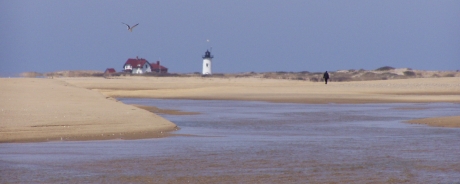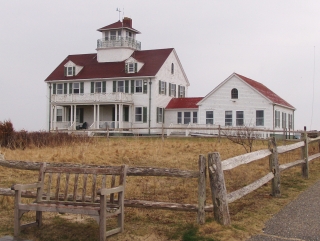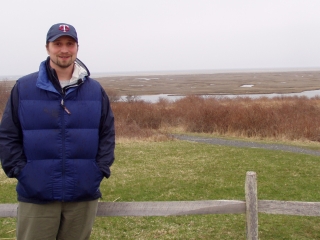Cape Cod National Seashore
Outer Cape Cod, Mass.
Visited: April 11, 2004
NPS Site Visited: 21 of 353
NPS Website; Local Website.

WHAT IS IT?
Almost the entire upper half of the ‘forearm’ of Cape Cod. Nearly 45,000 protected acres of recreational beaches, shoreline, sand dunes, freshwater kettle ponds and swamps. The Site, which exists around and amidst the towns and peoples of the northern Cape, also includes lighthouses, the place of the initial Pilgrim landing as well as the location of the first transatlantic wireless telegram.
BEAUTY (7/10)
The Cape holds an odd mangled and rugged beauty. Glacial shifts created this strange landscape but the erosion caused by both the wind and the ocean define it. In some places the whipping coastline turns into shifting dunes that transition to gnarled forests growing out of swampland. Because of the wind, nothing here grows very tall. Scrubby pines dot the landscape while trees twist in menacing ways. One gets the impression that the winds and the ocean are an inevitable force that will someday envelope the land itself.
HISTORIC SIGNIFICANCE (6/10)
You have the Pilgrims’ landing, the Pilgrims’ first encounter with the Native Americans, Marconi’s transatlantic wire, lighthouses, dramatic glacial shift, rapid erosion and so many other things that we did not learn.
 CROWDS (5/10) CROWDS (5/10)
We had no problem with traffic or crowds. We took solitary and silent walking trails through the swamps and along the dunes. We anticipate that it is not this way in summer.
The crowds had already started in Provincetown; a town surrounded on three sides by the Park and one the other by the bay. Come May: ay yi yi.
EASE OF USE/ACCESS (4/5)
The National Park directional signs are everywhere. Walking and bicycle trails are clearly marked. A great portion of the trails are paved for handicap accessibility. Once the crowds get larger traffic and access might get a little more difficult.
CONCESSIONS/BOOKSTORE (3/5)
Only one of the two Visitor Centers was open off-season. It was undergoing a major reconstruction and was located in a trailer. Nonetheless the book selection was good. One can only expect improvement when the new Visitor Center opens.
COSTS (2/5)
Off-season was free. During summer, it is $7 a day for beach access, $20 for the season. Off-road vehicle costs are $65 for the season, $40 for a week.
RANGER/GUIDE TO TOURIST RATIO (3/5)
There were a few Rangers at the Visitor Center.
TOURS/CLASSES (7/10)
Rangers give talks and guided nature hikes throughout the summer. There were geological and historical explanation panels at a great many stops along the seashore. Trail-specific pamphlets explaining your route are provided in a wooded box at the start of the many walking hikes. Trees along the way are marked for your botanical knowledge.
 FUN (7/10) FUN (7/10)
We were transfixed by the landscape and impressed at how a living and working community exists within Park lands and Gab has a strong affinity for off-season beach towns.
WOULD WE RECOMMEND? (7/10)
It is a testament to the National Park Service that they have been able to protect so much prime beach real estate from over-commercialization and over-population. It is still beautiful here in Cape Cod. Thank you John F. Kennedy.
TOTAL 51/80
|